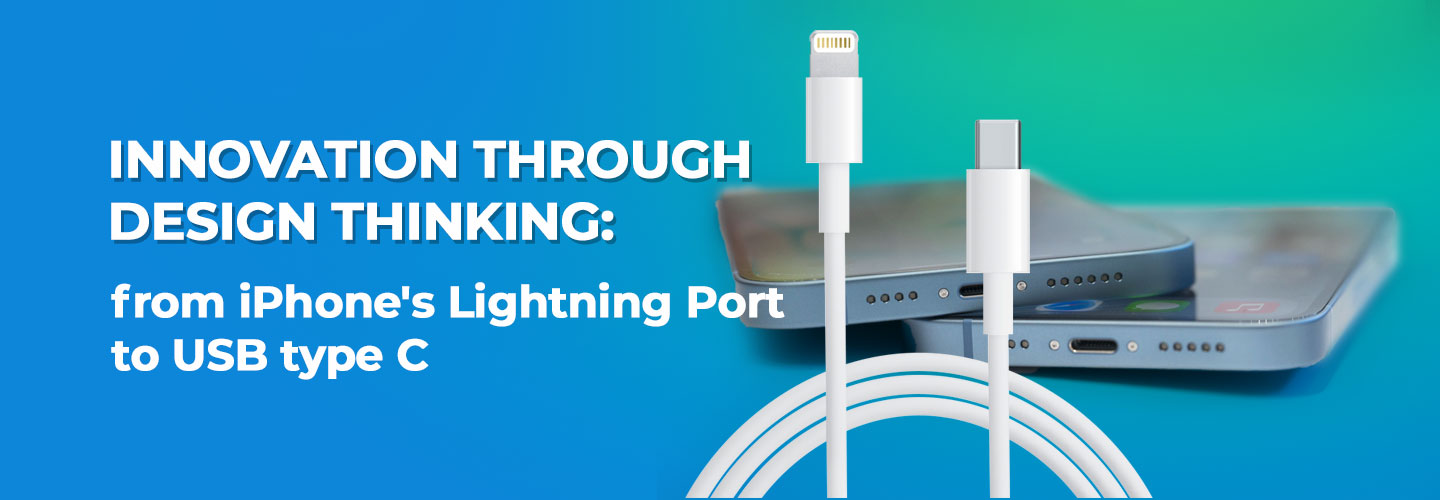Innovation through Design Thinking: from iPhone's Lightning Port to USB type C

In today's fast-paced business world, innovation is the lifeblood of success. Organizations strive to address ever-evolving challenges and meet the demands of a dynamic customer base. Design thinking, a method gaining prominence in innovation management, has become a go-to strategy for companies looking to stay competitive. This article examines the power of design thinking, with a particular focus on Apple's journey through innovation, from the introduction of the lightning port to the recent shift to USB Type C.
Apple's Evolution: The Lightning Port and the USB Type C Metamorphosis
Apple's history is rife with groundbreaking innovation, and the iPhone, since its 2007 debut, has continually pushed boundaries. Take, for instance, the introduction of the lightning port with the iPhone 5 in 2012. This decision, though met with mixed reactions, was driven by design thinking principles.
The lightning port replaced the traditional 30-pin connector, providing a more user-friendly and efficient charging and data transfer solution. Apple observed how people interacted with their devices, understood their needs, and created a versatile charging system. Over a decade, the lightning port became a pivotal component of Apple's exclusive ecosystem.
The Transition to USB Type C: is It User-Centric?
Apple has now made a significant shift with the iPhone 15, replacing the lightning port with USB type C. This change prompts the question: Is it rooted in Apple's commitment to its users' needs or a response to external factors?
Some users may view this transition with scepticism, wondering if it aligns with Apple's user-centric ethos. However, the move to USB type C is partially influenced by the European Union's directive to standardize USB type C across all devices by the end of 2024. This standardization aims to enhance user experience, ensuring compatibility and convenience across different devices. It's especially welcomed by travellers in EU member states, who will no longer need multiple chargers. While the change may reduce Apple's product exclusivity, it also reflects the brand's adaptability to evolving regulatory environments.
USB Type C, unlike Apple's exclusive Lightning port, diverges from Apple's typical proprietary design approach and owes its existence to the cooperative efforts of the USB Implementers Forum, a consortium boasting diverse industry leaders, including Apple, alongside tech giants like Intel and Microsoft. This collective endeavour represents a pivotal transformation within the tech industry, where major players acknowledge the critical need for standardized, universally adaptable solutions.
The transition to USB Type C is a combination of Apple's commitment to addressing user needs and a pragmatic response to external factors, such as the European Union regulations. This shift underscores the evolving nature of design thinking and its integration with external influences.
Design Thinking and the Evolution of Enterprise
Apple's journey from the lightning port to USB Type C serves as a resounding testament to the transformative power of design thinking in catalyzing innovation and shaping exclusive ecosystems. Nonetheless, it concurrently beckons thought-provoking contemplation on the intricate interplay of external influences in the arc of product evolution.
Design thinking undeniably remains a formidable instrument for businesses, ushering in user-centric solutions and fostering adaptability. Yet, the equilibrium between catering to user needs and assimilating external factors perpetuates as an enduring subject of discourse, particularly as enterprises, like Apple, navigate the labyrinthine and ever-shifting landscape of contemporary commerce. (FSP)